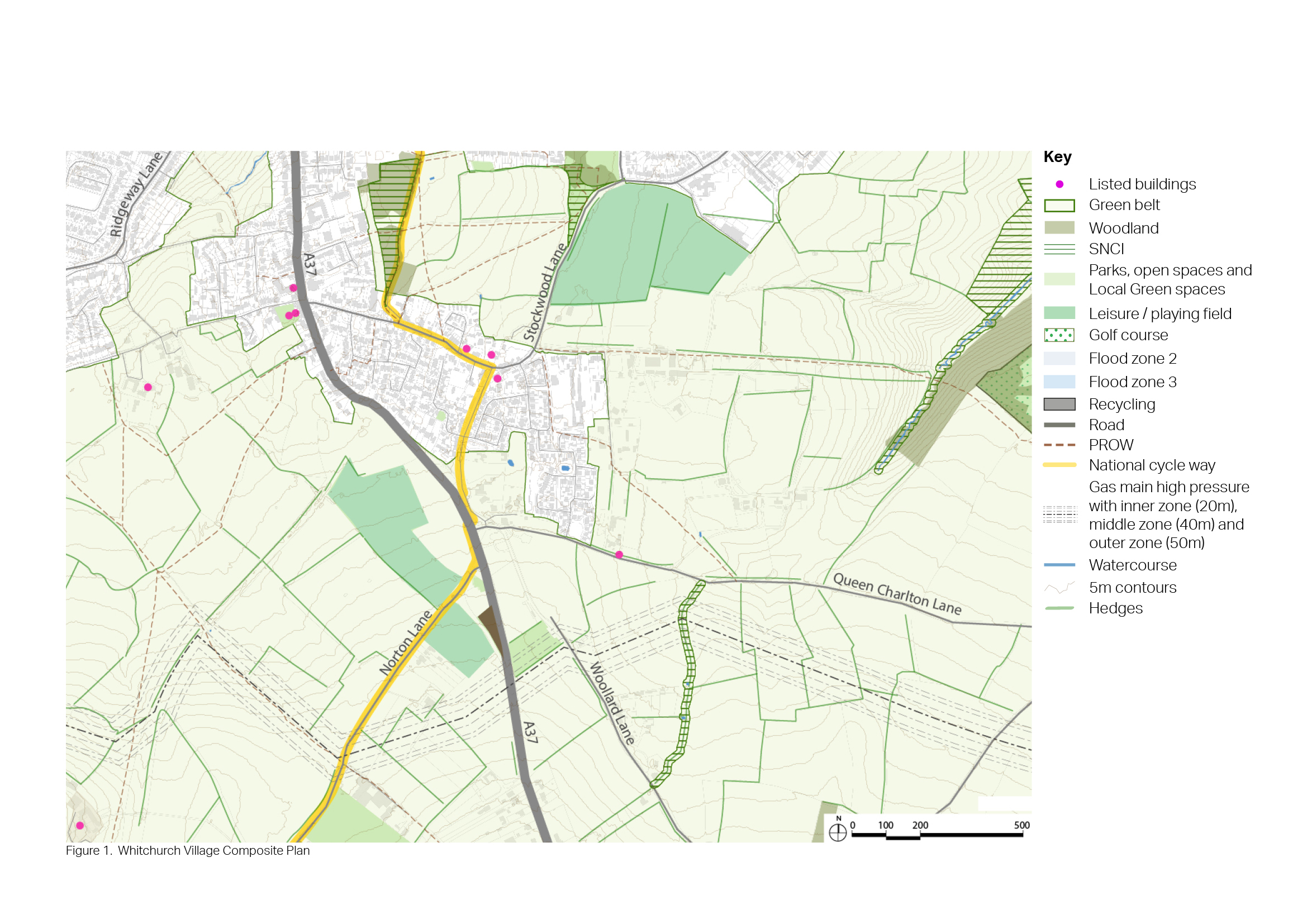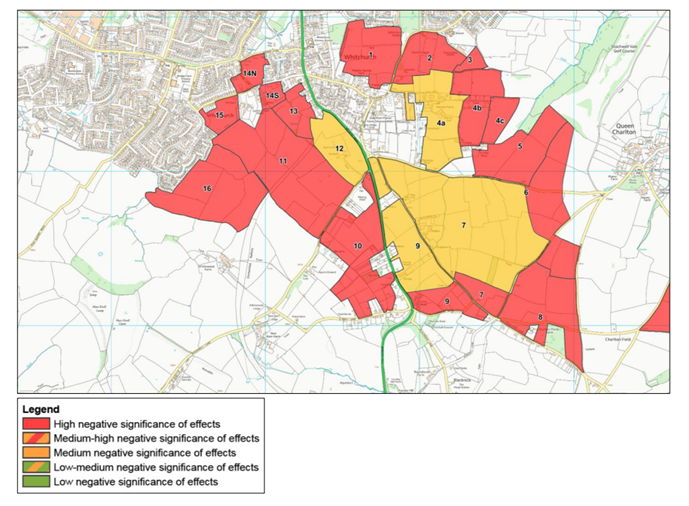Select a section below to read more detail.
6.84 Whitchurch Village is located within the northern part of B&NES, with a population of around 2,000 people. It sits directly south of Stockwood and east of Hartcliffe in Bristol. The administrative area of Bristol City Council lies immediately to the north and east of the Village. The village of Queen Charlton lies to the east, and the town of Keynsham to the north east. More recent development has increased the number of houses in the village by around 250 homes, but did not bring with it any supporting facilities. The existing village lacks certain amenities such as a village shop, although the existing music shop sells some convenience goods.
6.85 Whitchurch Village is surrounded nearly entirely by Green Belt, separating it from Bristol to the north and west, and Keynsham to the east. Any new development adjoining the village would require the removal of land from the Green Belt, and removal would require 'exceptional circumstances' to be fully evidenced and justified.
Figure 38: Context plan - Whitchurch Village
Transport issues and strategic planning
6.86 The local transport network for Whitchurch Village is characterised by the dominance of private car journeys. This contributes to the high traffic volumes on the A37 which bisects the village. The lack of sustainable alternatives, notably a railway station, results in a high proportion of out-commuting, particularly to Bristol. For local journeys, walking, cycling and wheeling are not popular choices because of the lack of safe and convenient routes. There are a limited range of destinations served by direct bus services, although Whitchurch Village is well-served by frequent bus services to Bristol City Centre.
6.87 The WECA Joint Local Transport Plan 4 (JLTP4) identified the South East Bristol Orbital Low Carbon Corridor project as an opportunity to provide a multimodal orbital corridor close to Whitchurch Village to facilitate north/south connectivity. However, this project is now under review through the preparation of WECA Joint Local Transport Plan 5 (JLTP5), which is being prepared in the context of the Climate Emergency declared by each of the local authorities.
Heritage sensitivity
6.88 Various important heritage assets are located within and surrounding the village. Of particular note is Maes Knoll Scheduled Ancient Monument, which is located around 2km to the south west of Whitchurch Village (see Figure 39 below). Maes Knoll is a substantial, univallate fort enclosing the eastern end and highest point of a plateau of high ground running approximately west to east for around 3km from East Dundry. Maes Knoll is a visually prominent local landmark, with its distinctive flat-topped profile visible across large areas of Bristol and north-east Somerset. In turn, views from the site are very extensive, reaching as far as both Severn crossings and a swathe of historic Somerset. The setting of Maes Knoll is defined by its hilltop location. Its elevated location affords panoramic views of the immediate fields on the hillslopes and the green buffer surrounding suburban Bristol.
6.89 A Statement of Heritage Significance and Appraisal of Risk of Harm for all heritage assets in and around Whitchurch Village, including Maes Knoll Scheduled Ancient Monument, has been carried out to inform the preparation of the options set out in this chapter. The diagram below provides a summary of this assessment, indicating, using a RAG rating, the parcels of land on which development would likely cause the most harm to the significance of one or more heritage assets.
6.90 The options shown below for Whitchurch Village have been directed to locations where harm to heritage assets would likely fall within the NPPF definition of ‘less than substantial harm’ or could be reduced by appropriate mitigation such as landscape design solutions. Any future development on land parcels assessed to cause less than substantial harm to a heritage asset will need to weigh this harm against any public benefits that are provided by developing the parcel.
6.91 View the Whitchurch Village Heritage Assessment
Figure 39: Extract from LUC Heritage Impact Assessment
| Rating | Level of risk of harm to heritage asset |
|---|---|
| Very high | An area of high importance and sensitivity, where development would have the greatest impact. The development of the site is likely to be of such a scale that the significance of the heritage asset would experience significant harm, up to and potentially including ‘substantial harm’ for the purposes of the NPPF, with no potential for meaningful mitigation. |
| High | An area of high importance and sensitivity, where development would have a significant impact. Development of the site is likely to result in a significant harmful impact on the significance of the heritage asset, but this could be reduced (but not removed) via appropriate mitigation. |
| High to medium | Area of medium-high importance and sensitivity where development would have a harmful impact if no mitigation occurred. Development of the site could result in a harmful impact on the significance of the heritage asset but this impact is likely to fall within the definition of ‘less than substantial harm’, and/or could be reduced via appropriate mitigation (such as via landscape design solutions). |
| Medium | Area of medium importance and sensitivity. The development of the site may result in a harmful impact to the significance of a heritage asset but it is likely that these impacts could be avoided via appropriate mitigation (such as via landscape design solutions). |
| Medium to low | Area of medium to low sensitivity. Potential impact will be of such a minimal scale that the significance of the heritage asset will not be harmed. |
| Low | Area of low sensitivity. Development of the site is likely to result in minimal impact on the significance of the asset. It is likely that no mitigation would be required. |
Landscape sensitivity
6.92 The area is also highly sensitive in terms of landscape impact. A Landscape and Visual Impact Assessment was carried out in 2017, which assessed the significance of effects of development on landscape and views for land parcels surrounding Whitchurch Village. The summary results of the assessment are shown on the diagram below. All of the site options for Whitchurch Village include development of parcels rated as having a high or medium-high negative significance of effects. These are noted in the constraints for each site, and if any allocations are proposed in Whitchurch Village at Draft Plan stage, these will need to be informed by additional landscape sensitivity work, and consideration of potential mitigation.
Figure 40: Extract from 2017 Landscape and Visual Impact Assessment
- Lack of employment in the local area results in out-commuting, mostly by car.
- Whitchurch Village is surrounded nearly entirely by Green Belt, separating it from Bristol to the north and west, and Keynsham to the east.
- A number of important heritage assets are located in and around the village, including Maes Knoll and Wansdyke Scheduled Ancient Monuments located to the south west.
- Landscape sensitivity assessments carried out in the area surrounding Whitchurch Village indicate that land located to the south of the village, between the village and Maes Knoll, is of particularly high landscape sensitivity, apart from a small parcel of land directly adjoining the A37 to the west, which is assessed to have a medium landscape sensitivity. Parcels of land directly adjoining the village to the east are also assessed as having a medium landscape sensitivity, becoming more highly sensitive moving further east.
- There is currently no dedicated shop in the village to buy convenience goods, though the existing music shop sells some convenience items. There are a limited number of commercial units, a pub / restaurant, a primary school and sports facilities. Growth of the village in recent years did not include provision of any supporting facilities.
- The village primary school is currently close to capacity, with no space for on-site expansion. The existing school could accommodate pupils from around 150 new homes, but any larger scale of development would need to be supported by a new primary school.
- Secondary age pupils from any new development at Whitchurch Village will need to be transported to Broadlands School in Keynsham, at cost to the Council. These pupils will not be able to travel to school sustainably by active modes.
- High traffic volumes cause congestion issues along the A37 corridor, particularly at peak times.
- Footway widths are narrow at points along the A37, and the carriageway width is frequently constrained by on-street parking.
- The village play park is well-used, but is located along the A37 at the southern end of the village, accessed via a very narrow footpath along A37. A new signalised crossing to be installed as part of the Whitchurch Village Low Traffic Neighbourhood Scheme will improve access to the play park from the east.
- The A37 severs the east and west parts of the village, and there are limited pedestrian crossings across the busy road.
- There are inadequate walking and cycle facilities on the A37 corridor, owing to the constrained carriageway and footway widths along parts of its length.
- There are limited orbital routes available for journeys to the northeast and northwest of the Whitchurch Village for both the private car and sustainable modes.
6.93 The following list sets out the key priorities and objectives for Whitchurch Village. Many of the priorities can be addressed by new development, and site options have been selected in response to the key issues, priorities and objectives. However, there are some priorities that won’t be addressed through new development but will be addressed through other policies in the Local Plan or initiatives undertaken by the Council or by other stakeholders.
- Maximise the delivery of affordable housing responding to local social and economic needs, and local demographics, including provision of homes fit for downsizing and single people.
- Provision of small-scale local employment space in order to provide the opportunity for local residents to be able to access and thrive in good work.
- Retain green buffer between Bristol and Whitchurch Village, in order to ensure that the two do not merge.
- Preserve and enhance the settlement’s village identity.
- Provision of new local facilities such as a village shop, community facilities and spaces to increase social interaction and encourage local living.
- Protect heritage assets and their settings.
- Protect areas of landscape sensitivity.
- Maximise ecological mitigation and Biodiversity Net Gain.
- Create a safe and attractive walking route between the village centre and the existing playground located to the south of the village.
- Enhance connectivity and access to the surrounding countryside including to Maes Knoll through better provision of active travel routes.
- Encourage the use of sustainable travel choices and reduce reliance on car use.


